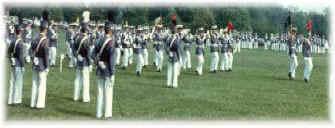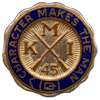
KMI HISTORY:The
Kentucky Military
Institute enjoyed a long and prestigious history in the field of
education
in Kentucky. It drew students from all over the country, especially
from
the Ohio valley and the South. Not only an educational institution, but
also a social element in the life of Kentucky's capital city. Older
family
papers and records reflect this fact. The institute, founded in 1845,
was
chartered on 20 January 1847. The school was to be operated as a quasi
military corps of the commonwealth, and the Governor was authorized to
issue a commission of "Colonel" to the Superintendent. The school was
to
be open to any commissioned officer of the state militia, and to such
other
students as could qualify themselves "after a full examination upon all
branches of the arts and sciences, and literature taught at the
institute,
and upon satisfactory evidence that said graduates have been engaged in
literary pursuits for three years thereafter, or have remained at the
Institute,
as residents for one year." Upon meeting these qualifications cadets
were
graduated with the appropriate degree, or "the degree of graduate of
the
Kentucky Military Institute."
Two years later, the General Assembly of Kentucky amended the charter of the Kentucky Military Institute to include the Franklin Institute in its organization. The name of the institution was changed to the Kentucky Collegiate and Military Institute. The Institute operated many years as a collegiate institution with state chartered literary societies and chapters of national Greek letter fraternities, including Alpha Tau Omega, Chi Phi, Delta Kappa Epsilon, Phi Delta Theta, and Sigma Alpha Epsilon. The creation of the school followed the pattern being set in the rest of the South by operating military institutes, ostensibly to serve as an officer training adjunct to the state militia systems. Training in these military institutes was to become a noteworthy mark in the South, and the military annals of both the region and the Nation were filled with the names of officers and other respected individuals who had graduated from their classrooms. The Kentucky Military Institute, or "KMI" as it was affectionately known, graduated hundreds of students who not only went into military service, but also filled the literary and scientific mandate of the original charter. In his selected biographical sketches of graduates and former cadets of "KMI," James Darwin Stephens has created a veritable panoply of some of the schools best known graduates and heroes. He documents in good measure the fact that the Institute met the challenges set for it by the Kentucky General Assembly in 1847. The Kentucky Military Institute went through a series of moves and academic metamorphoses before it finally ceases operation as a military school in the spring term of 1971. Stephens has been selective of the subjects which he shows as representative of much of the Institute's long operational history. The several personal sketches represented in this collection cover a wide chronological range, and an interesting assortment of personal experiences. Among these are several soldiers, enlisted men and officers who gave a good account of themselves from the Civil War through the Vietnam campaigns. Included are those men who were awarded the Congressional Medal of Honor and others whose decorations filled their chests with medals, ribbons, and supplementary clusters of all descriptions. Associated with the names of KMI graduates and former cadets were such historic moments as Bull Run, Chickamauga, Missionary Bridge, Stone's River, Wilderness, Gettysburg, San Juan Hill, Wounded Knee, World Wars I and II, the cross compartments of Korea, and the battles in Vietnam. Several of these men fell in battle while others were seriously wounded or disabled. In all
of their
dramatic exploits and noble careers many of these men of KMI brought
personal
credit to themselves and to history. Some with varied eccentricities
and
noteworthy differences forged honorable military careers, distinguished
by acts of great personal bravery, while others persevered in other
walks
of life. Several became known as judges, representatives, senators,
editors,
state and county officials, stage, and screen actors. Numerous such
lives
and experiences are recalled by Stephens in this book. He illuminates a
rather personal history of the Kentucky Military Institute with various
sketches and colorful characteristic profiles. His work gives a good
example
of this phase of Kentucky educational history, which endured more than
a century of successful operation. In the careers of its graduates and
former cadets, Stephens shows in some detail how they lived up to the
ideals
and expectations expressed in KMI's original charter of 1847.
Thomas
D. Clark
Professor-emeritus of History University of Kentucky |
 "HISTORY of KMI" The founder of the Kentucky Military Institute, Robert T. P. Allen, was born in Baltimore, MD in 1813. He graduated 5th in his class at West Point, was a Captain in the Seminole War and during the Civil War was the commander of a Texas infantry regiment. He married Julia Bond, niece of President Andrew Jackson, whom he met while visiting the White House. In 1845, Allen purchased property south of Frankfort, KY, believing it would be a good location for a private military school. Established as the Kentucky Military Institute it had a reputation for excellent instructors, strict discipline and demanding academic courses. After the Civil War, the school changed its curriculum to prepare students for professional occupations. Allen was said to be a genius and worked on several inventions. Around the age of 60, he invented the KMI Steam Engine, the Allen typewriter and a steam wagon, precursor to the modern day automobile. During the early years, KMI went through bankruptcy, fires and even revolt of the cadets. In 1894, Col. Charles Fowler obtained the KMI charter after the school's original site was sold through bankruptcy, and transferred the charter to his school, the Kentucky Training School in Mt. Sterling. He continued operations as the Kentucky Military Institute after merging the two schools. Among the KTS students who were transferred to KMI, were seven young women. The "cadet-ettes" never wore the traditional blue-gray uniforms, but followed the same academic curriculum and disciplinary rules as the male cadets. In 1896 he purchased a historic plantation house in Lyndon, KY and opened for the new fall term. Col. Fowler believed that outdoor recreation in the Florida climate would be a great benefit to students in their scholastic work. He established winter quarters in Eau Gallie, now Melbourne, FL, in 1906. This began the annual trip to Florida for the winter session. After two fires, one in Lyndon, KY and the other at Eau Gallie, FL, KMI again went into bankruptcy. In the fall of 1924, Col. Charles B. Richmond and three other teachers formed a partnership and bought the KMI properties and reopened with an enrollment of 150 cadets. Col. Richmond's 40-year tenure has been described as the "Golden Age of KMI". Like Col. Fowler, he believed wholeheartedly in the positive benefits of the Florida climate on the cadets scholastic abilities. Consequently, in 1932, Col. Richmond began searching for a new winter campus. After studying many other sites, he chose Venice. The San Marco Hotel, the Venice Hotel and the Annex between them were leased for 7 years from the Brotherhood of Locomotive Engineers before being purchased by the school. The San Marco Hotel, a 3-story, modern, fireproof building, was said to be the strongest structure in the city, built with reinforced concrete. The arcade hall could be used to assemble the whole cadet battalion in case of inclement weather. The 2nd and 3rd floors of this building were sleeping quarters for the cadets with the ground floor shops became classrooms, study hall and offices for the staff. The San Marco is now the Venice Centre Mall filled with specialty shops on the ground floor and condominiums on the 2nd and 3rd floors. The Venice Hotel, now Park Place, housed school officers and was also used during inclement weather. The 1st floor contained offices for the administration, the kitchen, dining room and a beautiful lobby. The 2nd and 3rd floors had apartments for faculty and rooms for the younger cadets. The Annex was used as the infirmary. Included in the original lease was a large bath house, located on the Gulf which contained dressing rooms and "shower baths". The school also used a nine-hole golf course and club house, as well as the open field between Tampa and Venice Avenues for drills, maneuvers and bi-monthly parades. This field is now Centennial Park and a municipal parking lot. Parents desiring to stay in Venice were encouraged to stay at the Park View Hotel. It had electric elevators, steam heat and a telephone and private bath in every room. The Park View Hotel was demolished to build the current Venice Post Office. Advertisements
for the school were placed
in 1932 issues of the Cosmopolitan magazine. Tuition expenses for
that 9 month school session,
The first trip to Venice, Florida began on January 4, 1933, leaving Military Park Station on the Louisville and Nashville Railroad and arriving 40 hours later at the Seaboard Air Line Railway station in Venice. Approximately 1500 people turned out to greet the train at 5 o'clock that Thursday. On January 7th, a reception for the cadets started with an auto tour, with local citizens donating the use of their cars. Signs welcoming the cadets were displayed in Bradenton, Sarasota, Nokomis and as far away as Tampa. Although the drill field had not been completed, the first formal dress parade was held on January 14th, in front of the San Marco Hotel. The 25-piece Cadet Band provided the music. The
students followed a regular course
of military study as outlined by the war department. The motto for the
school was "Character Makes The Man". During Col. Richmond's
term,
if anyone was caught consuming an alcoholic drink, he was sent home on
the next train or bus.
Col. Richmond had an aggressive outreach program to increase enrollment and even during the depression years his successful business ability gave KMI some of its largest enrollments. He also helped many promising local boys who otherwise could not have afforded to attend KMI by making them working students. Jobs as barbers, staff assistants, kitchen workers, and mess hall attendants were offered. In 1940, KMI acquired the Orange Blossom garage which was redone for a gymnasium and classrooms. This building is now the Venice Little Theatre. Over the next 37 years, many military balls, dress parades and sporting events, were held with great excitement and attendance of the local residents. Local newspapers were filled with articles about the KMI activities. There was the inevitable rivalry between the KMI sports teams and area schools with headlines reporting many KMI wins. A young woman invited to a military ball accepted this honor with excitement, and after receiving an invitation would have to meet the approval of the school's superintendent. Needless to say, Venice businesses, farmers and citizens profited because of the presence of the KMI. Some cadets that attended KMI went on to become celebrities. Victor Mature attended KMI in 1928-1930; he was known for his participation in films, such as "Samson & Delilah"and "My Darling Clementine". Jim Backus attended KMI between 1928-1930; he was best known for creating the comic character, "Mr. Magoo" and playing the stranded banker on "Gilligan's Island". Fred Willard attended in 1949-1951; he was best known for regular appearances on the popular weekly TV program during the 70s and 80s, "Real People". He most recently starred in the comedy, "Best In Show", as loose-lipped, sports TV commentator, Buck Laughlin. Anti-war
beliefs during the Viet Nam
War diminished enrollments for the military school, and the school
closed
and sold its properties in 1973. The last trip to Florida was made in
January
1970.
Prepared by Cindy Gnegy, January 2001
Venice Archives and Area Historical Collection
|
| Kentucky
Military Institute www.kmialumni.org Send e-mail to: kmimail@kmialumni.org Copyright © All rights reserved. |
 |